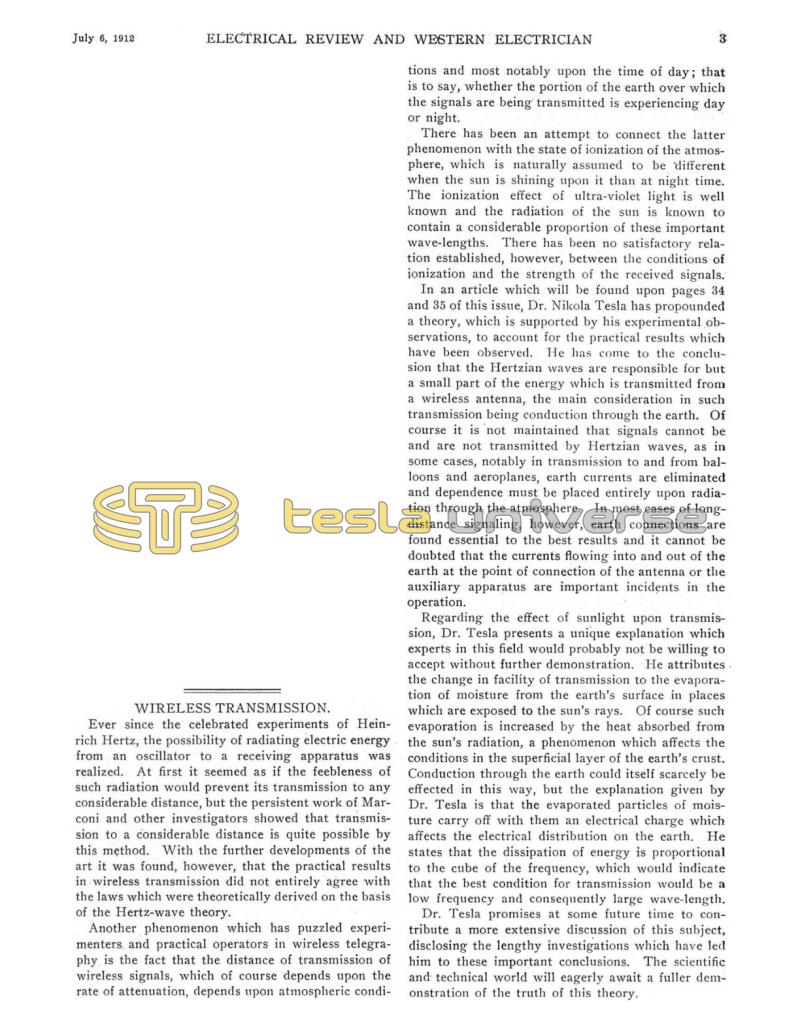
Nikola Tesla Articles
Wireless Transmission
Ever since the celebrated experiments of Heinrich Hertz, the possibility of radiating electric energy from an oscillator to a receiving apparatus was realized. At first it seemed as if the feebleness of such radiation would prevent its transmission to any considerable distance, but the persistent work of Marconi and other investigators showed that transmission to a considerable distance is quite possible by this method. With the further developments of the art it was found, however, that the practical results in wireless transmission did not entirely agree with the laws which were theoretically derived on the basis of the Hertz-wave theory.
Another phenomenon which has puzzled experimenters and practical operators in wireless telegraphy is the fact that the distance of transmission of wireless signals, which of course depends upon the rate of attenuation, depends upon atmospheric conditions and most notably upon the time of day; that is to say, whether the portion of the earth over which the signals are being transmitted is experiencing day or night.
There has been an attempt to connect the latter phenomenon with the state of ionization of the atmosphere, which is naturally assumed to be different when the sun is shining upon it than at night time. The ionization effect of ultra-violet light is well known and the radiation of the sun is known to contain a considerable proportion of these important wave-lengths. There has been no satisfactory relation established, however, between the conditions of ionization and the strength of the received signals.
In an article which will be found upon pages 34 and 35 of this issue, Dr. Nikola Tesla has propounded a theory, which is supported by his experimental observations, to account for the practical results which have been observed. He has come to the conclusion that the Hertzian waves are responsible for but a small part of the energy which is transmitted from a wireless antenna, the main consideration in such transmission being conduction through the earth. Of course it is not maintained that signals cannot be and are not transmitted by Hertzian waves, as in some cases, notably in transmission to and from balloons and aeroplanes, earth currents are eliminated and dependence must be placed entirely upon radiation through the atmosphere. In most cases of long-distance signaling, however, earth connections are found essential to the best results and it cannot be doubted that the currents flowing into and out of the earth at the point of connection of the antenna or the auxiliary apparatus are important incidents in the operation.
Regarding the effect of sunlight upon transmission, Dr. Tesla presents a unique explanation which experts in this field would probably not be willing to accept without further demonstration. He attributes the change in facility of transmission to the evaporation of moisture from the earth’s surface in places which are exposed to the sun’s rays. Of course such evaporation is increased by the heat absorbed from the sun’s radiation, a phenomenon which affects the conditions in the superficial layer of the earth’s crust. Conduction through the earth could itself scarcely be effected in this way, but the explanation given by Dr. Tesla is that the evaporated particles of moisture carry off with them an electrical charge which affects the electrical distribution on the earth. He states that the dissipation of energy is proportional to the cube of the frequency, which would indicate that the best condition for transmission would be a low frequency and consequently large wave-length.
Dr. Tesla promises at some future time to contribute a more extensive discussion of this subject, disclosing the lengthy investigations which have led him to these important conclusions. The scientific and technical world will eagerly await a fuller demonstration of the truth of this theory.
